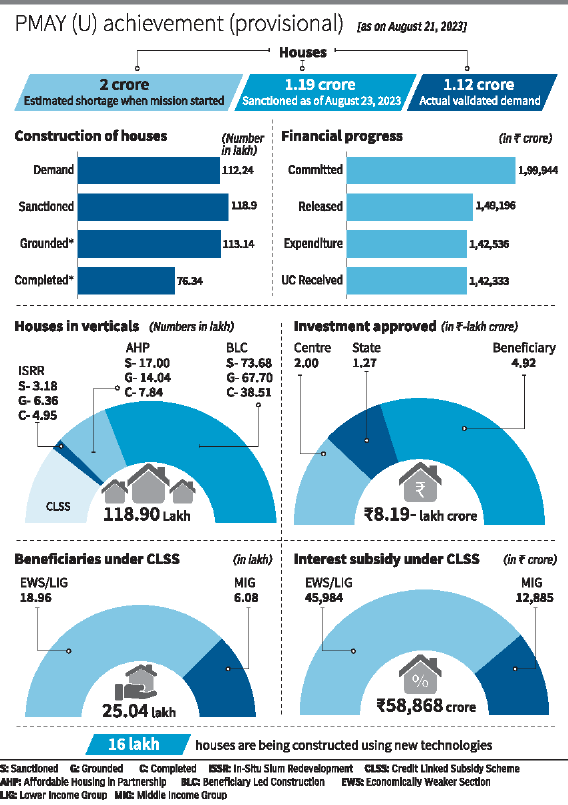

‘Mission incomplete’, PMAY-U set for extension
Flawed Mechanism? Allowing States and UTs to assess housing needs has led to sanctioning of lower number of houses than needed
DEEP DIVE.
The Government of India’s ambitious Pradhan Mantri Awas Yojana-Urban (PMAY-U) ‘Housing for All’ Mission, started in June 2015 to provide pucca houses to all eligible urban beneficiaries, will end in December next year. But the mission may still be incomplete because the gap between needs, demand and supply prevails. In fact, the Standing Committee onHousing and Urban Affairsin its report submitted to Parliament has highlighted the need to extend the existing scheme with modification or launch a new scheme to fulfil the mission.
The Ministry of Housing and Urban Affairs, which is implementing the PMAY-U ‘Housing for All’ Mission initially intended to address a total housing shortage of two crore.
However,as per the government data, overall 1.19 crore houses have been sanctioned as of 23 August 2023.
Initially, it was proposed that 1.8 crore slum households and 20 lakh non-slum poor be covered under the Mission. However, the actual validated demand for housing under PMAY(U) stands at about 1.12 crore (112.24 lakh).
The housing shortage was based on estimates, while PMAY-U adopted a demand-driven approach by allowing States and Union Territories to assess housing needs in four vertical areas of PMAY(U).
The Ministry has accepted that it did not conduct any independent urban housing need assessment study and data reveal that ‘Housing for All’ in urban areas seems mission incomplete as of now.
According to the 2001 Census, there were 286.1 million people living in urban India. That climbed steeply to 377.1 million in the 2011 Census — a growth of 2.76per centannually.
Infrastructure challenges in terms of affordable housing remain a challenge with more than 31 per cent of the total population living in urban areas.
The housing shortage estimated by Technical Group (TG)-12 was 1.88 crore over the period 2012-17. The slum households were projected to go up to 18 million. As per the 69th Round Report ofNSSO (2012), there were 33,510 slums (notified - 13,761 and non-notified - 19,749) in the country with88,09,007 households.
As per Census 2011 data, the total number of slum households stands at 139.20 lakh and the migrant population at 44.66 lakh. Taken together, the housing need for all States and UTs as per 2011 Census data stands at 183.86 lakh. However, only some States — Andhra Pradesh, Bihar, Gujarat, Jharkhand, Kerala, Assam, Manipur, Tripura Andaman andNicobarisland (UT) — have assessed the demand to be more than the total number of slums and the number of migrants taken together.
The projected demand by other States is lower than the sum of slum households and migrant population as per 2011 Census data. Hence, the demand generated by various States and UTs which was later validated by the Ministry of Housing and Urban Affairs remains short of the actual housing shortage.
However, the Ministry relied on States and urban local bodies to assess the actual demand in their jurisdiction without imposing any ceiling.
New scheme?
The Standing Committee has recommended that the Ministry conduct an impact assessment study of the scheme to find out the ground realities.
The Committee has also asked the Ministry to explore the feasibility of either extending the existing scheme with modifications based on an impact assessment study or formulate another such scheme to benefit the urban poor at large to achieve the objective of “Housing for All”.
The scheme is implemented through four verticals — Beneficiary Led Construction (BLC), Affordable Housing in Partnership (AHP), In-Situ Slum Redevelopment (ISSR) and Credit Linked Subsidy Scheme (CLSS) — based on eligibility criteria as per scheme guidelines.
ISSR includes slum rehabilitation of slum dwellers with the participation of private developers using land as a source whileCLSSincludes promotion of affordable housing through credit linked subsidy.
AHPaimsto provide affordable housing in partnership with public and private sectors while BLC includessubsidiesforbeneficiary-ledindividual house construction /enhancement.
Interestingly, government data show thatamaximum number of projects were sanctioned under the BLC vertical (60 per cent) and a minimum number of projects under ISSR vertical (3 per cent).
“The States also find it more convenient to give houses in smaller cities and to people who have their own land. This is why we have seen the BLC vertical growing,” the Ministry told the Standing Committee.
‘Misleading approach’
Government data show that a total of 5,13,654 houses are ‘unoccupied’ under the AHP vertical.
According to the Ministry, as per standard practices, construction under the AHP vertical is taken up block by block where each block consists of multiple dwelling units.
“As soon as the block gets completed, Mission acknowledges the completionof numberof houses,but suchcompleted dwelling units are unsafe for occupancy due to ongoing on-site construction activities including infrastructure facilities for other remaining blocks” the Standing Committee report mentions.
Such blocks/units become habitable only when all the on-site construction activities are over including physical and social infrastructurefacilities.
“The Committee is given to understand that the physical completion of houses,pending completion of the entire project and pending availability of basic amenities, is being counted as ‘completed’ houses. The Ministry without ensuring the liveability and occupancy of the houses which is the actual target of the mission is focusing on merely output,” the Standing committee stated in its March 2023 report.
The report added: “The committee strongly feels that this approach of the Ministry is misleading. The Ministry, being the nodal agency, should show the result in terms of outcome, that is, the number of houses actually occupied by beneficiaries and not merely output intermsof houses completed.”